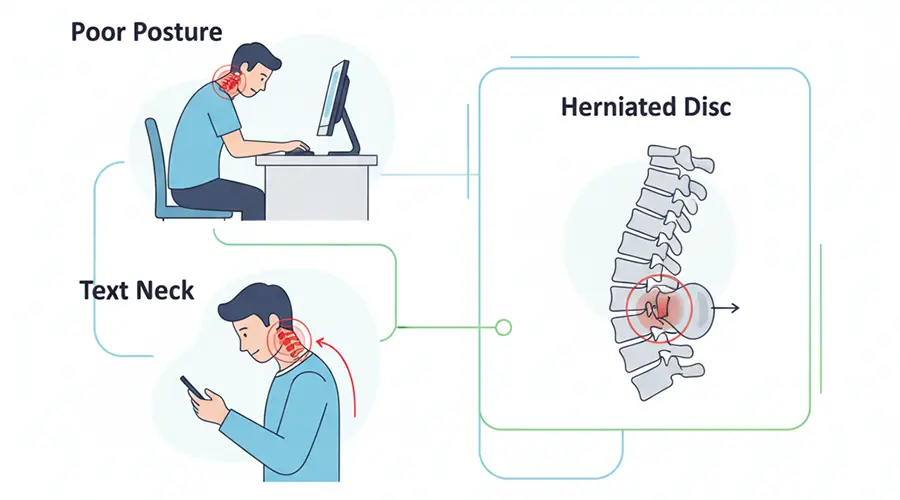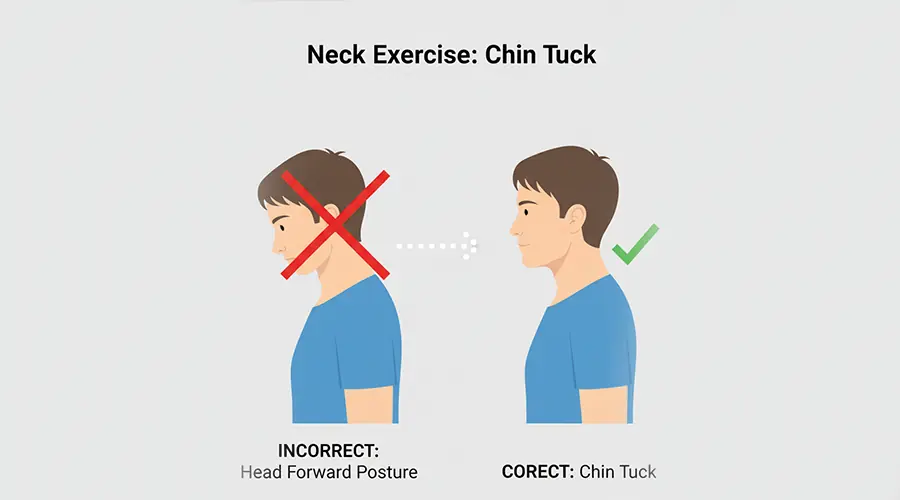Neck pain is one of the most common problems that can severely impact the quality of daily life. Fortunately, physical therapy stands out as one of the most effective and common treatment approaches, playing a key role in relieving pain, reducing muscle stiffness, and restoring the natural function of the neck. At Beyond Rehab, we believe that every individual is unique; for this reason, your treatment plan is specifically personalized to your needs and condition to achieve the best possible outcome.
Understanding Neck Pain: Causes, Symptoms, and When to See a Doctor
How Does Neck Pain Develop?

The cervical spine is a remarkable structure composed of seven vertebrae that supports your skull and provides a wide range of motion for your head. Due to this flexibility, the neck is vulnerable to injuries and conditions that lead to pain and restricted movement. While most cases of neck pain are not serious and improve with simple treatments, they can sometimes be a sign of a more serious medical issue.
What Are the Most Common Causes of Neck Pain?
-
Poor Posture: Hours of sitting at a desk, bending over a mobile phone ("text neck"), or sleeping in an improper position.
-
Repetitive Motions: Activities that require constant turning or movement of the head.
-
Acute Injuries: Sports injuries, car accidents (whiplash injury), or falls.
-
Degenerative Diseases: Cervical osteoarthritis (wear and tear of the joints), herniated cervical discs, and spinal stenosis.
-
Other Medical Conditions: Infections, tumors, or vertebral fractures, which are less common.
When Is Neck Pain Dangerous and Requires Medical Attention?
If your neck pain is accompanied by any of the following conditions, see a doctor immediately:
-
Pain resulting from a serious injury, such as an accident or a fall.
-
The pain is severe and unbearable.
-
Despite home remedies, the pain does not improve or worsens.
-
It is accompanied by symptoms like numbness, weakness, tingling, or a pins-and-needles sensation in the arms and legs.
To make an accurate diagnosis, your doctor may use methods such as X-rays, MRI, CT scans, electromyography (EMG), and blood tests.
Goals and Impact of Physical Therapy on Neck Pain (A Patient-Centered Approach)
Our primary goal in physical therapy is not just to reduce pain but to improve your overall quality of life. We focus on the following objectives:
-
Reduce Pain and Stiffness: Using specialized techniques to relieve pain and increase flexibility.
-
Improve Range of Motion: Restoring your ability to turn and bend your head without pain.
-
Strengthen Muscles: Strengthening the deep neck muscles and the supporting muscles in the back and shoulders for better spinal support.
Even if the pain is not completely eliminated, physical therapy helps you return to your daily activities by better managing your symptoms.
Physical Therapy: Scientific Evidence and Efficacy
Numerous scientific studies and research provide moderate to strong evidence supporting the effectiveness of physical therapy in reducing pain and improving function in individuals with neck pain. The key to success is full adherence to the treatment plan prescribed by the physical therapist and performing the home exercises correctly.
When Is Physical Therapy for the Neck Recommended, and When Is It Not?
When Physical Therapy for the Neck Is Recommended
-
Chronic Pain Without a Clear Cause: In these cases, strengthening the muscles can provide better support for the spine and reduce pain.
-
Recovery from Injury: After injuries like whiplash, physical therapy helps rebuild strength and flexibility.
-
Post-Surgical Rehabilitation: After surgeries such as Anterior Cervical Discectomy and Fusion (ACDF), physical therapy is vital for relieving stiffness and restoring neck function.
When Physical Therapy for the Neck Should Be Avoided
-
Significant Spinal Instability: In cases like a vertebral fracture or severe disc pressure on the spinal cord.
-
Serious Underlying Medical Problems: The presence of an active infection or a tumor in the neck area.
-
Patient Intolerance: If the patient cannot perform the treatment due to severe pain.
Physical Therapy Treatment Methods for the Neck
Your treatment program will be a combination of two main approaches: passive and active therapies.
Passive Physical Therapy for Neck Pain

These methods are performed on you by the physical therapist, and their main goal is to reduce initial pain and swelling.
-
Heat/Cold Therapy: Using ice packs to reduce inflammation in the early stages and hot packs to increase blood flow and relax muscles.
-
Massage Therapy: Massage techniques to reduce muscle tension and spasms.
-
Electrotherapy (TENS): Using a mild electrical current to alter pain signals to the brain.
-
Ultrasound: Sending sound waves into deep tissues to reduce pain and relax muscles.
Risks and Potential Issues of Passive Physical Therapy
Although these methods are generally safe, improper use can lead to skin damage (from direct ice or heat) or a temporary increase in pain. Over-reliance on passive therapies can also slow down the recovery process.
Active Physical Therapy for Neck Pain

This is the core of your treatment and involves you moving your own body to strengthen muscles and increase flexibility. You can find examples of foundational movements in our guide to physiotherapy exercises.
-
Neck Stretches and Exercises: Specific exercises like "chin tucks" to improve posture and strengthen deep neck muscles.
-
Core and Back Strengthening: Strong abdominal and back muscles provide a solid foundation for the entire spine, including the neck.
-
Aerobic Activity: Low-impact exercises like stationary cycling, swimming, or brisk walking that increase blood flow and aid in recovery.
-
Aquatic Exercises (Hydrotherapy): Water reduces pressure on the joints, making it easier to perform exercises.
Risks and Potential Issues of Active Physical Therapy
An initial increase in pain or stiffness is normal and can be managed by starting exercises gradually. Performing exercises with incorrect technique can lead to new injuries, so it is crucial to follow the physical therapist's instructions carefully. If you feel unusual pain, stop the exercise and consult with your specialist.
The Importance of Continuing Exercises After Physical Therapy Ends
The end of your physical therapy sessions does not mean the end of your treatment. To prevent the recurrence of pain, especially in cases caused by poor posture, continuing a maintenance program at home is essential.
Home Remedies for Neck Pain (Complementary to Physical Therapy)
These strategies can be used as temporary relief alongside your primary treatment.
-
Use Hot and Cold Packs: Use ice for the first 2-3 days, then switch to heat to increase blood circulation.
-
Neck Massage: Gently massage the painful area to reduce muscle tension.
-
Perform Gentle Stretching Exercises: Simple movements like shoulder rolls, squeezing shoulder blades together, and gentle head turns can reduce stiffness.
When Are Home Remedies Not Enough?
If the pain is not controlled with these methods, gets worse, or limits your mobility, be sure to seek professional care.
Benefits of Physical Therapy for Quality of Life and Prevention
Physical therapy is more than just a treatment; it's a preventive approach for your future.

-
Education on Proper Posture: Learning how to sit, stand, and work correctly to prevent re-injury.
-
Improved Quality of Life: A quicker return to your favorite activities without pain and limitations.
-
Non-Surgical Treatment: Physical therapy is often an effective solution for conditions like a herniated disc and can eliminate the need for surgery.
In-Home Physical Therapy for the Neck
For patients who are unable to visit a clinic due to spinal cord injury, old age, or mobility issues, we offer specialized in-home physical therapy services to ensure the treatment process is conducted in a comfortable and familiar environment.
Frequently Asked Questions (FAQ)
What is physical therapy for neck pain and how does it help?
When is physical therapy recommended for neck pain?
In which cases should one not undergo physical therapy for neck pain?
What are the active and passive physical therapy methods for neck pain?
Does physical therapy for neck pain have any side effects or potential issues?
What are the main benefits of physical therapy for neck pain?
Is in-home physical therapy for the neck also possible?
What exercises can be done at home to relieve and prevent neck pain?
Ourphysiotherapy services in Dubaiare designed to provide a personalized recovery plan for your neck pain. Contact our expert team to schedule your consultation.



